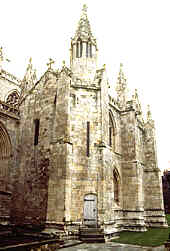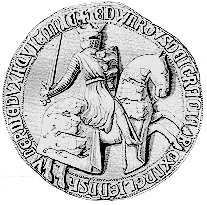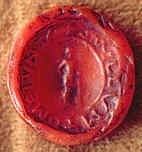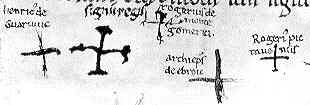






If you are looking at this page without frames, there is more information about medieval writing to be found by going to the home page (framed) or the site map (no frames).
| Scribes and Libraries | |||
| Until into the 12th century, most books were produced by monastic scribes. The development of monastic libraries entailed the lending of books between institutions for copying. Sometimes these transactions have been recorded, and sometimes the chains of copying can be identified through anomalies in the text which have been copied down the chain. | |||
| Scribes were sometimes identified by name in a colophon added to the manuscript when it was complete. From these, and from inscribed illustrations of the scribe which are sometimes found, it appears that in the earlier period, as in Anglo-Saxon England for example, the scribe was also the illustrator. | |||
| The Bodleian Library website displays a self portrait of my favourite monk, Hugo pictor, scribe and illustrator of a late 11th century Commentary of St Jerome on Isaiah (MS Bodley 717, f.287v, detail). | |||
 |
|||
| The name of the scribe, Dubthac, on a 9th century transcription of Priscian's grammar in the Leiden University Library (Cod. Lat. 67, f.7b). (From New Palaeographical Society 1904) Be assured that the nasty red graffiti is only on the digital version, for your clarification. | |||
 |
|||
| It is not known for certain exactly how the work was organised. Monasteries had a library which also served as a scriptorium, but writing work may also have been carried out in other better lit locations, such as in the cloister or even outdoors. (So it has been postulated, but in a Yorkshire Cistercian house situated just below the moors - well, maybe.) It has been suggested that purpose-built scriptoria and libraries may only date from the 13th or 14th century. Previously books were stored in special cupboards and taken out for reading in carrels in the cloister, or loaned out for private reading for extended periods. | |||
| At Selby Abbey, a Benedictine house in Yorkshire, the scriptorium stood above the sacristy, attached to the chancel of the church. | |||
 |
In Gloucester Abbey, the study carrels for the monks survive in the cloister. | ||
| You can get a great view of the Gloucester cloisters and their carrells if you watch the movie Harry Potter and the Philosopher's Stone very carefully. Don't be distracted by the troll! | |||
| Presumably there were highly skilled scribes who specialised in writing work. Certainly the work of certain named scribes has been identified through the idiosyncracies of individual handwriting. Even large libraries of several hundred volumes accumulated over several hundred years would not have required a major input from an entire monastic community. The image of serried ranks of monks scribbling away in unison is probably just the stuff of cartoons. | |||
| Probably, even when one scribe was responsible for the completion of an entire work, the writing was carried out on loose gatherings or quires before the work was bound. Illustrative depictions of scribes do not, on the whole, tend to show them writing into bound books. | |||
| Areas in Italy and southern France which retained Roman law employed secular scribes and notaries for the production of legal and bureaucratic documents. It is likely that the royal notaries of the Merovingian and Carolingian chanceries were literate churchmen, possibly combining their functions in government with their religious duties. In other areas it is likely that even royal documents were produced in monastic scriptoria. In England a royal chancery may have come into being in the 10th century. | |||
| During the 12th and 13th centuries there was a relatively rapid change in the mode of production of books. Secular scribes were employed by booksellers to transcribe books on a commercial basis. The monasteries themselves began purchasing books from commercial booksellers rather than transcribing them themselves. | |||
| This resulted in a division of responsibility for the various phases of production of a book. The bifolia were prepared, pricked and ruled and presented in gatherings to the scribe. The scribe left appropriate spaces for decorative initials, miniatures, borders and rubric headings, and was occupied purely with transcribing the text. The rubricator became a specialised job, acting also as a proofreader indicating errors in the main text or correcting them himself. The illustrator then added the decoration according to the instructions of the bookseller, who often acted in consultation with the customer or patron. (See De Hamel 1986) |  |
||
| This rather scruffy decorative initial has been added at a later date to the text, partly overwriting it, from a 15th century volume of Virgil, by permission of the University of Tasmania Library. | |||
| In certain universities, the need for textbooks by students resulted in a particular system of book production known as the pecia system, which operated on a commercial basis. Books were transcribed by stationers into loose quires or gatherings, which were then hired to students for a limited time in order that they could make their own copies. They thus transcribed and assembled their own textbooks from segments. (See Pollard 1978) | |||
 |
The greater significance of written record in administration led to the appointment of an increasing army of scribes appointed to government. In England there developed various royal secretarial offices, each identified with the seal used to authenticate documents. Terms like privy seal became a shorthand for the whole legal process involving that office. | ||
| The Great Seal of Edward I | |||
| In England from 1199 letters issued from the Chancery were transcribed on to parchment rolls. When the volume and variety became too great for a single roll, they were divided among a series of rolls covering particular areas. The Royal Exchequer also kept mountainous quantities of financial records. The courts of common law transcribed their proceedings on to Plea Rolls. A vast quantity of all this material is still extant, although scholars always decrie the losses in the particular area that they need right now. (See Elton 1969) | |||
| By the latter half of the 13th century, scribes were employed in towns and villages to record official transactions and bureaucratic matters. Manorial bailiffs were using written records for management of resources. Travellers were required to carry written certificates of good character. Clerks were employed to draw up accounts, send letters and keep records in an environment where those using written records were still not proficient at writing. (See Clanchy 1993) | |||
| The system of using notaries for drawing up and authenticating documents for members of the public was founded in the Roman system. This was continued in the more southerly regions of western Europe. It does not appear in England until the latter half of the 13th century, and then only in relation to papal business. A notary not only drew up the document, but authenticated it with his signature and with a further distinctive sign of his own. | |||
| The use of the unique signature of an individual was not widespread. Official documents were authenticated by seal. The presence of witnesses could be indicated by the recording of their names, sometimes beside the sign of the cross. This was a final relic of authentication by oral testimony, as the witnesses were required to swear orally rather than sign their names. Individual signatures on legal documents had become more common by the 15th century. |  |
||
| Replica of the seal of Thomas Becket. | |||
 |
Crosses of the king (second left) and some of the witnesses to a late 11th century charter in Eton College Library. (From New Palaeographical Society 1904) | ||
| Towards the end of the middle ages there is evidence that more people were becoming their own scribes, being competent to write letters in their own hand and to sign their own names. It is only at this time that writing became less of a profession and more of a life skill, and then only for a certain proportion of the population. | |||
|
|
|||
|
If you are looking at this page without frames, there is more information about medieval writing to be found by going to the home page (framed) or the site map (no frames). |
|||